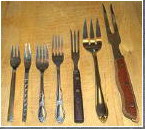Teachable Moment
the Teachable Moment
What is The History of the Fork?
The modern word for “fork” comes from the Latin word “furca,” which means “pitchfork”. The first forks were carved from wood or animal bones for use as cooking utensils and serving tools around 2000 B.C. in Ancient Egypt, China and Greece.
Around the 1st century A.D., the Roman Empire produced bronze and silver forks. The personal table fork, used for eating rather than serving, was probably invented in Ancient Greece or the Eastern Roman (Byzantine) Empire, around the 4th century. By the 9th century, it was used in Persia and the Middle East. In the 11th century, the table fork became prevalent in Italy since the three prongs made it easier to gather pasta and spaghetti noodles than the wooden spike formerly used.
By the 17th century, the fork was almost universal among the wealthier classes in Southern Europe. In the French court it was proper for a guest to arrive for dinner with his own fork and spoon in a box called a cadena. Most of northern Europe adopted the fork around the 18th century, and it did not become popular in North America until around the time of the American Revolution in 1776. The table fork has adapted many times. Early on, it had only two tines and was flat, but the design introduced in 18th century Germany had 4 tines and a curved design for piercing and scooping food. Now there are many types of forks for different uses such as the meat fork, olive fork, oyster fork, and fondue fork. But the invention of plastic has enabled experimenting with hybrid models such as the “spork” (spoon/fork), the “knork” (knife/fork), and the “sporf” (spoon/fork/knife).






